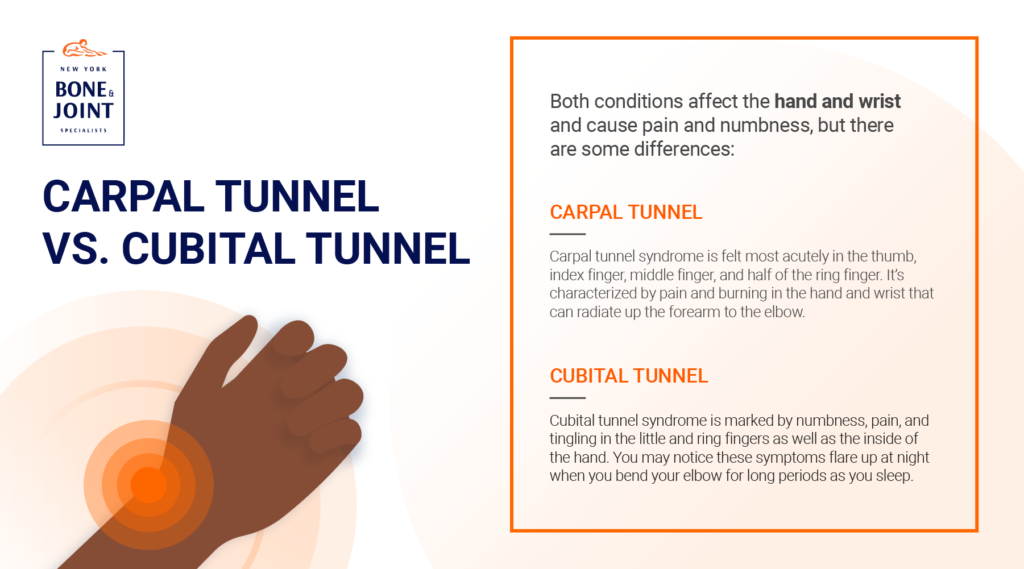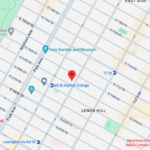Aching elbows and tingling fingers can be a sign of cubital tunnel syndrome. Find out what causes this common injury and how our hand and wrist specialists treat this nerve-related condition.
Sitting at a computer, holding a handheld device – these are all activities we engage in daily. However, a constant bend in the elbow like this can increase our risk of a condition called cubital tunnel syndrome, a compression of the nerves in the elbow joint.
If your elbow aches or your fingers tingle, you might have cubital tunnel syndrome. Our leading hand and wrist specialists possess the diagnostic expertise to accurately diagnose cubital tunnel syndrome and develop an effective treatment plan utilizing both conservative and surgical methods.
Understanding Cubital Tunnel Syndrome: The Ulnar Nerve Problem
The ulnar nerve extends from your neck to your hand. In the elbow, the ulnar nerve travels through the narrow cubital tunnel that stretches under the pointy bone of the elbow called the medial epicondyle. Because the nerve is so close to the skin, it can be “shocked” when the tip of the elbow is struck. That’s why it’s called the “funny bone.” But it’s not a bone you hit, but a nerve.
Beyond the elbow, the ulnar nerve runs along the inside of your forearm to your little finger through an area called Guyon’s canal. The ulnar nerve is what stimulates feeling in the little and ring fingers and the muscles of the hand. This nerve carries signals from the brain to the hand, enabling you to grip and bend your fingers.
Cubital tunnel syndrome develops when the ulnar nerve is compressed or overstretched. This can be caused by:
- Prolonged elbow flexion, such as bending the elbow when on the phone or sleeping.
- Direct pressure on the elbow from leaning on a chair armrest at work, in the car, or in the subway.
- Activities that require repetitive elbow bending, such as throwing a baseball.
- Previous injuries or conditions, such as a fracture or dislocation of the elbow or arthritis.
- Anatomical variations that cause the nerve to slide back and forth over the epicondyle, irritating it.
- A bone spur or fluid buildup in the elbow puts pressure on the nerve.
- Typing on a keyboard for work.
Cubital Tunnel Syndrome Symptoms: Recognizing Nerve Compression
Cubital tunnel syndrome is a progressive condition. The symptoms may be mild at first, but then advance to more severe symptoms. Early and accurate diagnosis is important to stop the condition from worsening with time.
Early symptoms
- Pain in the inside of the elbow.
- Numbness and tingling occur when the elbow is bent, like when typing at a keyboard.
- Tingling in the ring and pinky fingers, especially at night.
- “Pins and needles” sensations that come and go.
Advanced symptoms
- Constant numbness in the pinky and ring finger.
- Muscle weakness in the hand.
- Difficulty with small motor tasks, such as buttoning a shirt.
- Unable to grasp objects with the hand.
Severe symptoms, such as muscle weakness in the hand, need immediate medical evaluation. If left untreated, the muscles can atrophy. If the symptoms have continued for six weeks, see a cubital tunnel syndrome specialist.

Comprehensive Cubital Tunnel Syndrome Diagnosis
We use several techniques to decide on a cubital tunnel syndrome diagnosis.
Tinel’s sign. We tap on the tip of your elbow to see how the fingers react when the related nerve is compressed.
Elbow flexion test. Our specialist will check if the ulnar nerve slides out of its normal position when the elbow is bent.
Forment’s sign. You’ll grasp a flat object, like a piece of paper, to verify the strength in your hand and fingers.
Nerve conduction studies. This test evaluates the speed at which a signal travels down the nerve to detect a block or compression.
Magnetic resonance neurography. This special MRI can assess the severity of the nerve damage and rule out other conditions, such as a pinched nerve in the neck.
Cubital tunnel syndrome is often confused with carpal tunnel syndrome, but they are different. Carpal tunnel syndrome affects the median nerve in the wrist area and is felt in the thumb, index finger, and middle finger. Cubital tunnel syndrome is a compression of the ulnar nerve in the elbow and affects the pinky and ring finger.
Cubital Tunnel Syndrome Treatment: From Conservative to Surgical Solutions
Conservative Treatment (First-Line Approach)
- Conservative treatment is effective in treating cubital tunnel syndrome within six to 12 weeks, and will include:
- Activity modifications to avoid activities that bend the elbow, such as talking on the phone or typing with your elbows bent, for long periods.
- Ergonomic changes to your workstation.
- Nighttime splinting to keep your elbow straight when sleeping. Braces may also be worn in the daytime to immobilize and cushion the elbow and relieve pressure on the nerve.
- Anti-inflammatory medications such as ibuprofen and naproxen can reduce swelling around the nerve.
- Exercises to increase strength in the hand muscles, as well as nerve gliding exercises to reduce pressure on the nerve and increase range of motion.
- Corticosteroid therapy. A corticosteroid injection may be prescribed, but there is a risk of nerve damage. Alternatively, a limited course of oral steroids may be prescribed to relieve inflammation around the nerve.
Cubital Tunnel Syndrome Surgery
Surgery for cubital tunnel syndrome may be recommended if conservative treatments have failed after six weeks or if the pain and numbness interfere with hand and elbow function. But the main reason to consider surgery is progressive muscle weakness. Surgery has a high success rate in relieving symptoms.
If you have diabetes, your doctor may ask you to control your blood sugar before surgery. You should stop smoking for several weeks before the operation, which is done under general or local anesthesia.
Simple decompression. In a cubital tunnel release surgery, the ligament roof of the cubital tunnel is cut and divided to relieve pressure on the nerve. The ligament tissue will regrow with more space for the nerve. It’s done as an outpatient procedure. You’ll wear a soft splint or bandage with padding for a few weeks after surgery. Most people can resume light activity, such as walking and daily tasks, immediately after surgery and return to work a few days later.
Ulnar nerve transposition. The nerve is moved from behind the medial epicondyle to in front of it. This prevents the medial epicondyle from catching on the bone and stretching when the elbow is bent. A brace is needed for several weeks after surgery, and you may feel tingling and numbness in your fingers for a few days afterwards. Complete recovery may take several weeks.
Medial epicondylectomy.This surgery involves removing the medial epicondyle, the bony bump on the inside of the elbow, enabling the ulnar nerve to glide smoothly when the elbow is flexed and straightened.
Post-Surgical Recovery and Rehabilitation
You can expect full recovery from cubital tunnel syndrome surgery in about two to three months. To reduce post-surgical pain, take pain relievers and apply cold and hot packs. You’ll work with a physical therapist to restore full motion of the arm.
Office workers or those with a sedentary job can return to work in a few days. Those with more physically demanding jobs will need two to four weeks off from their employment.
Surgery is generally effective in treating cubital tunnel syndrome.
Cubital Tunnel Syndrome Exercises: Your Recovery Toolkit
Physical therapy and at-home exercises are essential in recovery from cubital tunnel syndrome. Here are several to try under the guidance of your physical therapist.
Elbow flexion and wrist extension:
- Sit tall and reach the affected arm out to the side, level with your shoulder, with the hand facing the floor.
- Flex your hand and pull your fingers up toward the ceiling.
- Bend your arm and bring your hand toward your shoulder.
- Repeat slowly 5 times.
Head tilt
- Sit tall and reach the affected arm out to the side with your elbow straight and arm level with your shoulder.
- Turn your hand up toward the ceiling.
- Tilt your head away from your hand until you feel a stretch.
- To increase the stretch, extend your fingers toward the floor.
- Return to the starting position and repeat slowly 5 times
Strengthening exercises build up the muscles in the hands and forearms to relieve pressure on the ulnar nerve.
Grip exercise
- Grab a soft stress ball or therapeutic putty.
- Squeeze the object in your hand, hold for a few seconds, and release.
- Perform 10-15 repetitions with each hand once a day.
Wrist curls
- Sit with your forearm on a table and your hand hanging off the edge, palm up.
- Using a light dumbbell, curl your wrist upwards slowly.
- Lower it back down and repeat.
- Do 10 repetitions on each side, twice a day.
Always consult with your doctor before starting a physical therapy regimen. Follow proper technique and stop if you feel intense pain. You may experience temporary numbness and tingling in the hand and arm with these exercises. If those symptoms persist after rest, consult with your doctor or physical therapist.
Cubital Tunnel Syndrome Brace and Splinting Options
The goal of a brace or splint is to prevent the elbow from excessive bending or to protect the elbow and ulnar nerve from pressure.
- Nighttime splints. The most recommended type, a rigid nighttime splint, is worn at night to keep the elbow from bending while sleeping.
- Padded sleeves. Padded elbow sleeves provide support and cushion the elbow, but are less restrictive than a full splint.
- Adjustable braces. These braces are built with stays that can be adjusted to allow some arm movement, but limit elbow flexion.
- Custom-made vs. off the shelf. Off-the-shelf braces are affordable, but may not provide a perfect fit. Custom-made options are more costly, but are fitted closely to the patient’s arm and elbow.
- Daytime brace. While nighttime braces are preferred, a padded daytime brace protects the elbow during certain activities, such as working at a computer.
When choosing a brace or splint, look for:
- Adjustable angles to move the elbow in a range of positions from 90 degrees to 180 degrees.
- Adjustable straps to allow for a good fit that’s snug but not too tight.
- Comfortable material made with breathable fabric and non-toxic substances that don’t irritate the skin.
- Interchangeable so they can be used on the right or left arm.
Consult with your doctor on the right brace for you. Also consider your activity level. Active people may need a more supportive brace. A brace is not a cure for cubital tunnel syndrome, but it is used in conjunction with physical therapy and other treatments. If deemed medically necessary by a physician, braces and splints for cubital tunnel syndrome are covered by insurance.
Preventing Cubital Tunnel Syndrome: Protecting Your Ulnar Nerve
Follow these strategies to keep your ulnar nerve safe:
- Don’t lean on your elbow or rest your elbow on a chair armrest for long periods.
- Avoid putting pressure on the inside of your arm by carrying heavy packages.
- Sleep with your elbow straight in a splint, or wrap a towel around your arm and tape it loosely in place.
- Limit activities that require excessive bending at the elbow.
Why Choose New York Bone & Joint Specialists for Cubital Tunnel Syndrome
At New York Bone & Joint Specialists, we provide holistic treatment taking into account the special needs of every patient. We will work with you every step of the journey to full recovery.
Here’s what we offer:
- Board-certified orthopedic and hand specialists with expertise in a variety of hand, wrist, and elbow conditions, like cubital tunnel syndrome.
- Comprehensive diagnostic capabilities, including X-rays, nerve studies, and a comprehensive physical exam.
- Conservative-first treatment philosophy that has proven successful in 90% of cases.
- Advanced surgical techniques are used when needed.
- Integrated rehabilitation services with a full staff of physical therapists.
- Multiple convenient locations around the city with same-day consultation available.
- We accept most Insurance programs and have a transparent billing process.
- We coordinate your care with occupational therapists and hand therapists.
- Expertise in workplace injury management if the cubital tunnel syndrome was due to your desk job.
FAQs: Cubital Tunnel Syndrome
What does cubital tunnel syndrome feel like?
Cubital tunnel syndrome symptoms begin as elbow pain and a tingling or numbness in the pinky and ring fingers. As the condition advances, you may experience muscle weakness that limits your ability to use your hand or arm.
How long does cubital tunnel syndrome take to heal?
Conservative cubital tunnel syndrome treatment can take anywhere from six to 12 weeks with physical therapy and bracing. Surgery may take three to six months. Recovery depends on the severity of the nerve compression and whether you follow a physical therapy program regularly.
Do cubital tunnel syndrome exercises really work?
Yes, exercises can successfully treat cubital tunnel syndrome, provided you follow the proper technique as shown by a physical therapist. Nerve gliding exercises are particularly effective in relieving pressure on the ulnar nerve.
When do I need cubital tunnel syndrome surgery?
For patients who have not been helped by conservative therapy after a few weeks, surgery may be the most viable option. Surgery is also indicated for patients with extreme muscle weakness in the hand. Surgery has a high success rate, but the condition may return.
What type of brace is best for cubital tunnel syndrome?
Nighttime braces are made specifically for nightwear to keep your elbow straight. For daytime wear, you can choose a padded brace to protect the elbow while performing certain activities, such as working at a computer. You can buy one off the shelf or custom-made. One study found that rigid nighttime bracing combined with activity modification for three months was successful in treating cubital tunnel syndrome.



